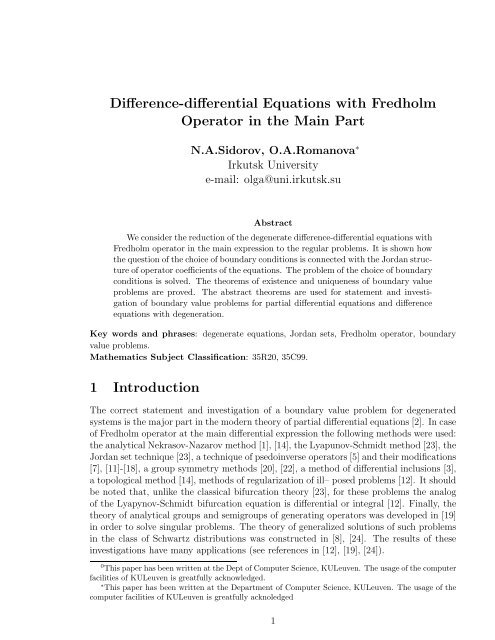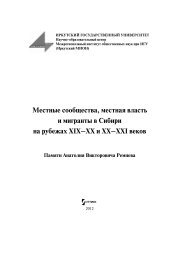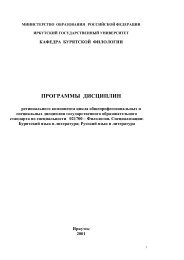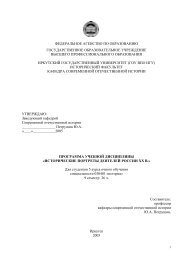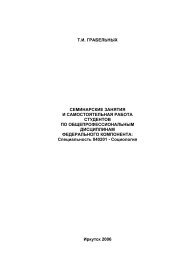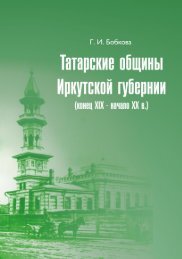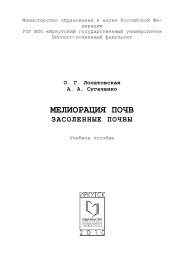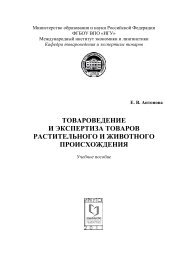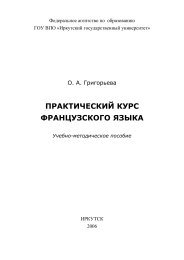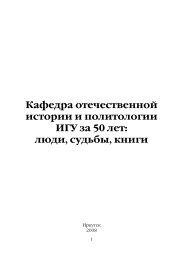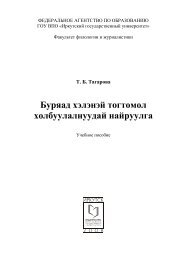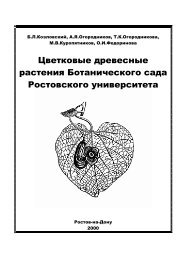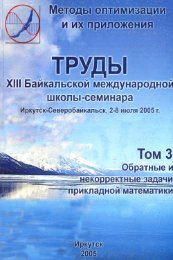Difference-differential Equations with Fredholm Operator in the Main ...
Difference-differential Equations with Fredholm Operator in the Main ...
Difference-differential Equations with Fredholm Operator in the Main ...
You also want an ePaper? Increase the reach of your titles
YUMPU automatically turns print PDFs into web optimized ePapers that Google loves.
<strong>Difference</strong>-<strong>differential</strong> <strong>Equations</strong> <strong>with</strong> <strong>Fredholm</strong><br />
<strong>Operator</strong> <strong>in</strong> <strong>the</strong> Ma<strong>in</strong> Part<br />
N.A.Sidorov, O.A.Romanova ∗<br />
Irkutsk University<br />
e-mail: olga@uni.irkutsk.su<br />
Abstract<br />
We consider <strong>the</strong> reduction of <strong>the</strong> degenerate difference-<strong>differential</strong> equations <strong>with</strong><br />
<strong>Fredholm</strong> operator <strong>in</strong> <strong>the</strong> ma<strong>in</strong> expression to <strong>the</strong> regular problems. It is shown how<br />
<strong>the</strong> question of <strong>the</strong> choice of boundary conditions is connected <strong>with</strong> <strong>the</strong> Jordan structure<br />
of operator coefficients of <strong>the</strong> equations. The problem of <strong>the</strong> choice of boundary<br />
conditions is solved. The <strong>the</strong>orems of existence and uniqueness of boundary value<br />
problems are proved. The abstract <strong>the</strong>orems are used for statement and <strong>in</strong>vestigation<br />
of boundary value problems for partial <strong>differential</strong> equations and difference<br />
equations <strong>with</strong> degeneration.<br />
Key words and phrases: degenerate equations, Jordan sets, <strong>Fredholm</strong> operator, boundary<br />
value problems.<br />
Ma<strong>the</strong>matics Subject Classification: 35R20, 35C99.<br />
1 Introduction<br />
The correct statement and <strong>in</strong>vestigation of a boundary value problem for degenerated<br />
systems is <strong>the</strong> major part <strong>in</strong> <strong>the</strong> modern <strong>the</strong>ory of partial <strong>differential</strong> equations [2]. In case<br />
of <strong>Fredholm</strong> operator at <strong>the</strong> ma<strong>in</strong> <strong>differential</strong> expression <strong>the</strong> follow<strong>in</strong>g methods were used:<br />
<strong>the</strong> analytical Nekrasov-Nazarov method [1], [14], <strong>the</strong> Lyapunov-Schmidt method [23], <strong>the</strong><br />
Jordan set technique [23], a technique of psedo<strong>in</strong>verse operators [5] and <strong>the</strong>ir modifications<br />
[7], [11]-[18], a group symmetry methods [20], [22], a method of <strong>differential</strong> <strong>in</strong>clusions [3],<br />
a topological method [14], methods of regularization of ill– posed problems [12]. It should<br />
be noted that, unlike <strong>the</strong> classical bifurcation <strong>the</strong>ory [23], for <strong>the</strong>se problems <strong>the</strong> analog<br />
of <strong>the</strong> Lyapynov-Schmidt bifurcation equation is <strong>differential</strong> or <strong>in</strong>tegral [12]. F<strong>in</strong>ally, <strong>the</strong><br />
<strong>the</strong>ory of analytical groups and semigroups of generat<strong>in</strong>g operators was developed <strong>in</strong> [19]<br />
<strong>in</strong> order to solve s<strong>in</strong>gular problems. The <strong>the</strong>ory of generalized solutions of such problems<br />
<strong>in</strong> <strong>the</strong> class of Schwartz distributions was constructed <strong>in</strong> [8], [24]. The results of <strong>the</strong>se<br />
<strong>in</strong>vestigations have many applications (see references <strong>in</strong> [12], [19], [24]).<br />
0 This paper has been written at <strong>the</strong> Dept of Computer Science, KULeuven. The usage of <strong>the</strong> computer<br />
facilities of KULeuven is greatfully acknowledged.<br />
∗ This paper has been written at <strong>the</strong> Department of Computer Science, KULeuven. The usage of <strong>the</strong><br />
computer facilities of KULeuven is greatfully acknoledged<br />
1
However, <strong>in</strong> all papers mentioned above <strong>the</strong> problems were considered, which could be<br />
<strong>in</strong>terpreted as ord<strong>in</strong>ary <strong>differential</strong> equations <strong>in</strong> Banach spaces. On <strong>the</strong> o<strong>the</strong>r hand, <strong>the</strong>re<br />
are a lot of systems of partial difference <strong>differential</strong> equations <strong>with</strong> a non<strong>in</strong>vertible operator<br />
<strong>in</strong> <strong>the</strong> ma<strong>in</strong> part, which can not be <strong>in</strong>terpreted <strong>in</strong> this way. So, <strong>in</strong> papers [6],[9], [10],<br />
significantly more complex degenerated partial <strong>differential</strong> equations <strong>in</strong> Banach spaces<br />
are considered. In this paper we develop <strong>the</strong> similar results for difference-<strong>differential</strong><br />
equations.<br />
Let us consider <strong>the</strong> follow<strong>in</strong>g equation<br />
Λu ≡ L 0 Bu + L 1 A 1 u + · · · + L q A q u = f(x), (1)<br />
where B and A i , i = 1, q are closed l<strong>in</strong>ear operators <strong>with</strong> <strong>the</strong> dense doma<strong>in</strong>s from E 1 to<br />
E 2 ; E 1 , E 2 are Banach spaces and D(B) ⊆ D(A i ), i = 1, q, x ∈ Ω ⊂ R r , B is <strong>Fredholm</strong><br />
operator <strong>with</strong> dimN(B) = dimN(B ∗ ) = n, R(B) = R(B), f(x) : Ω ⊂ R r → E 2 is a<br />
sufficiently smooth function; l<strong>in</strong>ear operators L i act on <strong>the</strong> sets of abstract functions,<br />
def<strong>in</strong>ed on x ∈ Ω ⊂ R r <strong>with</strong> <strong>the</strong> values <strong>in</strong> Banach spaces E 2 (E 1 ) and satisfy <strong>the</strong> follow<strong>in</strong>g<br />
conditions:<br />
1)D(L 0 ) ⊂ D(L 1 ) ⊂ D(L i ), i = 2, . . . , q;<br />
2)L 0 Bu(x) = BL 0 u(x), L i A i u(x) = A i L i u(x) on u(x) ∈ D(B) ∩ D(L 0 ).<br />
Conditions 1) and 2) are carried out, for example, for difference- <strong>differential</strong> operators<br />
of <strong>the</strong> follow<strong>in</strong>g form<br />
L i ( ∂<br />
∂x , ∆) = ∑<br />
|k|≤q i<br />
a i k (x)Dk + ∑<br />
|k|≤q i<br />
b i k (x)∆k ,<br />
where<br />
D k =<br />
∂ k<br />
∂x k ,<br />
1<br />
1 . . . ∂x kr<br />
r<br />
∆ k u =<br />
k 1 ∑<br />
i 1 =0<br />
k r<br />
∑<br />
. . . (−1) |k|−|i| C i 1<br />
k 1<br />
. . . C ir<br />
k r<br />
u(x 1 + i 1 h 1 , . . . , x r + i r h r ),<br />
i r=0<br />
q 0 > q 1 > q 2 ≥ . . . ≥ q q , a i k (x), bi k (x) : Ω ⊂ Rr −→ R 1 . In what follows L i will denote this<br />
concrete form of operators. It will be more convenient not to specify concretely D(L 0 ).<br />
The <strong>in</strong>vestigation of s<strong>in</strong>gular equation (1) is reduced to regular problems, i.e. to<br />
equations solvable <strong>with</strong> respect to <strong>the</strong> ma<strong>in</strong> part L 0 . A special decompositions of <strong>the</strong><br />
Banach spaces E 1 and E 2 <strong>in</strong> accordance <strong>with</strong> <strong>the</strong> generalized Jordan structure of <strong>the</strong><br />
operator coefficients B, A i , i = 1, q are used. This reduction makes it possible to pose<br />
boundary value problems for (1).<br />
2 P, Q-commutability of L<strong>in</strong>ear <strong>Operator</strong>s <strong>in</strong> Case of<br />
<strong>Fredholm</strong> <strong>Operator</strong><br />
Let E 1 = M 1 ⊕ N 1 , E 2 = M 2 ⊕ N 2 , P be a projector on M 1 along N 1 , Q be a projector on<br />
M 2 along N 2 , A be a l<strong>in</strong>ear closed operator from E 1 to E 2 , D(A) = E 1 , A ∈ {A 1 , . . . , A q }.<br />
2
Def<strong>in</strong>ition 1. If u ∈ D(A), P u ∈ D(A), AP u = QAu <strong>the</strong>n A(P, Q) -commutes.<br />
Suppose that φ i | n 1 is a basis <strong>in</strong> N(B), ψ i| n 1 is a basis <strong>in</strong> N ∗ (B), < φ k , γ i >= δ ki , i, k =<br />
1, n, < z i , ψ k >= δ ik , i, k = 1, n. Then based on [23] <strong>the</strong>re is a unique bounded operator<br />
Γ = (B + ∑ n<br />
i=1 < ., γ i > z i ) −1 .<br />
Suppose <strong>the</strong> follow<strong>in</strong>g condition is satisfied:<br />
1. <strong>Fredholm</strong> operator B has a complete A 1 -Jordan set φ (j)<br />
i , i = 1, n, j = 1, p i , B ∗ has a<br />
complete A ∗ 1- Jordan set ψ (j)<br />
i , i = 1, n, j = 1, p i , and <strong>the</strong> systems γ (j)<br />
i ≡ A ∗ 1ψ (p i+1−j)<br />
i , z (j)<br />
i ≡<br />
A 1 φ (p i+1−j)<br />
i , here i = 1, n, j = 1, p i , correspond<strong>in</strong>g to <strong>the</strong>m are biorthogonal [7].<br />
The projectors<br />
∑p i<br />
∑ n<br />
P =<br />
i=1 j=1<br />
∑ n ∑p i<br />
Q =<br />
i=1 j=1<br />
< ., γ (j)<br />
i<br />
< ., ψ (j)<br />
i<br />
> φ (j)<br />
i ≡ (< ., Υ > Φ), (2)<br />
> z (j)<br />
i ≡ (< ., Ψ > Z), (3)<br />
where k = p 1 + · · · + p n -root number, generate <strong>the</strong> direct decomposition<br />
E 1 = E 1k ⊕ E 1∞−k , E 2 = E 2k ⊕ E 2∞−k<br />
Corollary 1. The operator Γ(Q, P )-commutes, A 1 Γ(Q, Q)-commutes, ΓA 1 (P, P )-<br />
commutes, E 1∞−k , E 1k - <strong>in</strong>variant subspaces of <strong>the</strong> operator ΓA 1 , E 2∞−k , E 2k - <strong>in</strong>variant<br />
subspaces of <strong>the</strong> operator A 1 Γ.<br />
The proof is carried out by <strong>the</strong> substitution of <strong>the</strong> operators Γ, A 1 Γ, ΓA 1 <strong>in</strong> formulas<br />
(2), (3), tak<strong>in</strong>g <strong>in</strong>to account that ψ (j)<br />
i<br />
A 1 φ (j)<br />
i , γ (p i+1−j)<br />
i = A ∗ 1 ψ(j) i , i = 1, n, j = 1, p i .<br />
= (Γ ∗ A ∗ 1 )j−1 ψ 1 i , φ(j) i<br />
= (ΓA 1 ) j−1 φ 1 i , z(p i+1−j)<br />
i =<br />
Suppose <strong>the</strong> operator A(P, Q)-commutes, where P, Q are def<strong>in</strong>ed by formulas (2), (3).<br />
Then <strong>the</strong>re is a matrix A, such that AΦ = AZ, A ∗ Ψ = A ′ Υ [9]. This matrix is called <strong>the</strong><br />
matrix of (P, Q)-commutability.<br />
Corollary 2. The operators B, A 1 (P, Q)-commute and <strong>the</strong> matrices of (P, Q)-<br />
commutability are <strong>the</strong> symmetrical cell-diagonal matrices:<br />
A B = diag(B 1 , . . . , B n ), A 1 = diag(A 11 , . . . , A n1 ),<br />
where<br />
⎡<br />
B i = ⎢<br />
⎣<br />
0...0<br />
0...1<br />
.....<br />
01...0<br />
⎤<br />
⎥<br />
⎦<br />
A i1 =<br />
⎡<br />
⎢<br />
⎣<br />
0...1<br />
....<br />
1...0<br />
⎤<br />
⎥<br />
⎦ , i = 1, n.<br />
In case when k > n let us <strong>in</strong>troduce def<strong>in</strong>ition.<br />
Def<strong>in</strong>ition 2. The operator G (P, Q)-commutes quasitriangularly, if A G is upper<br />
quasitriangular matrix, whose diagonal blocks A ii of dimension p i × p i , p i ≥ 2 are lower<br />
right triangular matrices. If <strong>in</strong> addition p i ∗ = . . . = p i ∗ +s = 1, <strong>the</strong>n <strong>in</strong> matrix A G at <strong>the</strong><br />
left of bloc [A ij ] i,j=i ∗ ,i ∗ +s are nulls. 3
3 The Reduction of Equation (1) to Regular Problems<br />
Suppose:<br />
2. The operators A 2 , . . . , A q (P, Q)- commute.<br />
Then <strong>the</strong>re are matrices A i , i = 2, q, such that<br />
A i Φ = A i Z, A ∗ i Ψ = A′ i Υ<br />
Follow<strong>in</strong>g formulas (2), (3) we <strong>in</strong>troduce <strong>the</strong> projection operators P, Q, which generate<br />
<strong>the</strong> direct decompositions<br />
E 1 = E 1k ⊕ E 1∞−k , E 2 = E 2k ⊕ E 2∞−k .<br />
Note that ΓE 2∞−k ⊂ E 1∞−k<br />
We look for <strong>the</strong> solution of equation (1) <strong>in</strong> <strong>the</strong> follow<strong>in</strong>g form<br />
u(x) = Γv(x) + (C(x), Φ), (4)<br />
where Γ = (B + ∑ n<br />
i=1 < ., γ (1)<br />
i > z (1)<br />
i ) −1 is a bounded operator , v ∈ E 2∞−k , C(x) =<br />
(C 1 (x), . . . , C n (x)) ′ , C i (x) = (C i1 (x), . . . , C ipi (x)), Φ = (Φ 1 , . . . , Φ n ) ′ , Φ i = (φ 1 i , . . . , φ (p i)<br />
i ), i =<br />
1, n.<br />
Substitut<strong>in</strong>g expression (4) <strong>in</strong>to equation (1) and not<strong>in</strong>g that BΓv = v, s<strong>in</strong>ce BΓ =<br />
I − ∑ n<br />
i=1 < ., ψ (1)<br />
i > z (1)<br />
i , < v, ψ (1)<br />
i >= 0, we obta<strong>in</strong><br />
q∑<br />
q∑<br />
L 0 v + L i A i Γv + L 0 B(C, Φ) + L i A i (C, Φ) = f(x). (5)<br />
i=1<br />
i=1<br />
The operator Γ (Q, P )-commutes, so from condition 2 and corollary 1 it follows that<br />
QA i Γ(I − Q) = 0, (I − Q)A i ΓQ = 0. Hence, QA i Γv = 0, ∀v ∈ E 2∞−k . Accord<strong>in</strong>g to<br />
corollary 2 BΦ = A B Z, where A B = (B 1 , . . . , B m ) is a symmetrical cell-diagonal matrix.<br />
Consequently,<br />
(I − Q)BΦ = 0, (I − Q)A i Φ = 0, i = 1, q, (6)<br />
because (I − Q)Z = 0. The follow<strong>in</strong>g equalities hold:<br />
(A i (C, Φ), Ψ) = A ′ iC, (B(C, Φ), Ψ) = A B C. (7)<br />
Project<strong>in</strong>g equation (5) onto E 2∞−k us<strong>in</strong>g (6) we obta<strong>in</strong> <strong>the</strong> regular equation (solved<br />
accord<strong>in</strong>g to operator L 0 ):<br />
˜Lv = (I − Q)f(x), (8)<br />
where<br />
q∑<br />
˜L = L 0 + L i A i Γ. (9)<br />
i=1<br />
In order to determ<strong>in</strong>e <strong>the</strong> vector-function C(x) : R r → R k , we project equation (5)<br />
onto E 2k and us<strong>in</strong>g (7) we obta<strong>in</strong><br />
q∑<br />
L 0 A B C + L i A ′ iC =< f(x), Ψ > . (10)<br />
i=1<br />
4
So it is proved<br />
Theorem 1. Suppose conditions 1 and 2 are satisfied, f : Ω ⊂ R r → E 2 - sufficiently<br />
smooth function. Then any solution of equation (1) can be represented <strong>in</strong> <strong>the</strong> form<br />
u = Γv + (C, Φ)<br />
where v satisfies regular equation (8), and <strong>the</strong> vector C(x) is def<strong>in</strong>ed from system (10).<br />
S<strong>in</strong>ce detA B = 0, <strong>the</strong>n system (10) is degenerated <strong>in</strong> <strong>the</strong> general case. Let us specify<br />
<strong>the</strong> sufficient conditions on which <strong>the</strong> systems (10) is recurrent sequence of regular l<strong>in</strong>ear<br />
difference- <strong>differential</strong> equations (solved accord<strong>in</strong>g to operator L 1 ).<br />
Introduce <strong>the</strong> follow<strong>in</strong>g condition:<br />
3 The operators A 2 , . . . , A q commute quasitriangularly (see Def.2), or k = n.<br />
Lemma 1. Suppose conditions 1, 2, 3 are satisfied. Then system (10) is a recurrent<br />
sequence of l<strong>in</strong>ear difference- <strong>differential</strong> equations of order q 1 <strong>with</strong> <strong>the</strong> operators of <strong>the</strong><br />
form<br />
˜ L ks = L 1 +<br />
q∑<br />
i=2<br />
a ik<br />
p k −s+1,sL i .<br />
In particular, if condition 1 is satisfied and A 2 = . . . = A q = 0, system (10) takes <strong>the</strong><br />
form<br />
L 1 C ipi (x) =< f(x), ψ (1)<br />
i >,<br />
L 1 C ipi −s(x) =< f(x), ψ (s+1)<br />
i > −L 0 C ipi −s+1(x), s = 1, p i − 1, i = 1, n.<br />
Proof follows from lemma 2 [6] or lemma [10].<br />
So if <strong>the</strong> conditions of <strong>the</strong>orem 1 and lemma 1 are satisfied <strong>the</strong>n equation (1) can be<br />
reduced to regular equation (8) and to sequence of regular l<strong>in</strong>ear difference-<strong>differential</strong><br />
equations (10) <strong>with</strong> order q 1 . Thus under <strong>the</strong> condition 3 system (10) be pseudos<strong>in</strong>gular<br />
system.<br />
Remark. Based on lemma 1 <strong>the</strong> vector components c i <strong>in</strong> <strong>the</strong> case p i ≥ 2 are determ<strong>in</strong>ed<br />
from <strong>the</strong> recurrent sequence of l<strong>in</strong>ear equations of order q 1 . If p i ∗ = . . . = p i ∗ +s = 1<br />
<strong>the</strong>n <strong>the</strong> correspond<strong>in</strong>g elements c i ∗(x), . . . , c i ∗ +s(x) are determ<strong>in</strong>ed from <strong>the</strong> regular system<br />
of s + 1 equations of order q 1 . In particular if p 1 = · · · = p n = 1, <strong>the</strong>n A B become<br />
zero.<br />
4 The Choice of Boundary Conditions<br />
In this section conditions 1,2,3 are satisfied. In <strong>the</strong> preced<strong>in</strong>g section for <strong>the</strong> def<strong>in</strong>ition of<br />
projections (I − P )u, P u <strong>the</strong> solution u of equation (1) we constructed equation (8) <strong>with</strong><br />
regular operator<br />
q∑<br />
˜L = L 0 + L i A i Γ,<br />
i=1<br />
and system (10), splitt<strong>in</strong>g <strong>in</strong>to recurrent sequence of l<strong>in</strong>ear equations <strong>with</strong> regular difference<strong>differential</strong><br />
operators<br />
q∑<br />
L˜<br />
ks = L 1 + a ik<br />
p k −s+1,s L i.<br />
i=2<br />
5
The ma<strong>in</strong> part of operator ˜L has <strong>the</strong> order q 0 , <strong>the</strong> ma<strong>in</strong> part of operator Lks ˜ - <strong>the</strong><br />
order q 1 . Because q 1 < q 0 <strong>the</strong>n <strong>the</strong> boundary conditions on projections P u, (I − P )u may<br />
be different <strong>in</strong> <strong>the</strong> general case. If q 1 = 0 <strong>the</strong>n boundary conditions may be given only on<br />
<strong>the</strong> projection (I − P )u.<br />
Let ω = Ω 1 ∩ Ω 2 ⊂ Ω.<br />
We shall f<strong>in</strong>d <strong>the</strong> solution u : ω ⊂ R r → E 1 of equation (1), whose projections<br />
P u, (I − P )u are subjected to <strong>the</strong> follow<strong>in</strong>g boundary conditions:<br />
τ 1 (I − P )u = α(x), x ∈ ∂Ω 1 , (11)<br />
τ 2 P u = β(x), x ∈ ∂Ω 2 . (12)<br />
Here τ 1 , τ 2 are l<strong>in</strong>ear difference-<strong>differential</strong> operators <strong>in</strong> <strong>the</strong> space of abstract functions,<br />
which commute <strong>with</strong> <strong>the</strong> projection operator P and <strong>with</strong> <strong>the</strong> operators B, Γ. So <strong>the</strong> functions<br />
α(x), β(x) must satisfy conditions P α(x) = 0, (I −P )β(x) = 0. Let <strong>the</strong> conditions of<br />
<strong>the</strong>orem 1 be satisfied. We shall search for <strong>the</strong> solution u of equation (1), which satisfies<br />
boundary conditions (11), (12). Based on <strong>the</strong>orem 1 <strong>the</strong> solution has <strong>the</strong> form<br />
u(x) = Γv(x) + (C(x), Φ), (13)<br />
where v satisfies (8) and <strong>the</strong> condition Qv = 0. The components of <strong>the</strong> vector C can be<br />
f<strong>in</strong>d from system (10).<br />
Lemma 2. If v, C satisfy <strong>the</strong> boundary conditions<br />
τ 1 v = Bα(x), x ∈ ∂Ω 1 , (14)<br />
τ 2 (C, Φ) = β(x), x ∈ ∂Ω 2 , (15)<br />
<strong>the</strong>n solution (13) satisfies boundary conditions (11), (12).<br />
Proof. S<strong>in</strong>ce P u = (C, Φ), <strong>the</strong>n condition (12) holds if and only if condition (15) holds.<br />
S<strong>in</strong>ce Qv = 0, P Γ = ΓQ, <strong>the</strong>n (I − P )u = Γv. By apply<strong>in</strong>g <strong>the</strong> operator B to <strong>the</strong> both<br />
sides of this equality, we obta<strong>in</strong> v = B(I − P )u. ¿From here τ 1 v = τ 1 B(I − P )u = Bα(x),<br />
and so B[τ 1 (I −P )u−α(x)] = 0, i.e., τ 1 (I −P )u−α(x) ∈ ∑ c i φ i . So if v satisfies condition<br />
(14) <strong>the</strong>n v satisfies (11). Besides, it is not difficult to understand if v satisfies (11) <strong>the</strong>n<br />
v satisfies (14).<br />
Lemma 3. If Ker ˜L = {0} <strong>the</strong>n any solution vof equation (8) <strong>with</strong> condition (14) lies<br />
<strong>in</strong> <strong>the</strong> subspace E 2∞−k .<br />
Proof. S<strong>in</strong>ce QB = BP, P α(x) = 0, QA i Γ = A i ΓQ, <strong>the</strong>n <strong>the</strong> projection Qv satisfies<br />
homogeneous problem ˜LQv = 0. As Ker( ˜L) = {0}, <strong>the</strong>n Qv = 0 and v ∈ E 2∞−k .<br />
Suppose<br />
4. <strong>Operator</strong>s ˜L, Lks ˜ have <strong>the</strong> bounded <strong>in</strong>verses.<br />
Then based on lemma 2, lemma 3 and <strong>the</strong>orems 1 we obta<strong>in</strong> <strong>the</strong> follow<strong>in</strong>g results<br />
Theorem 3. Let conditions 1, 2, 3, 4 be satisfied. Then problem (1) <strong>with</strong> conditions<br />
(11), (12) has <strong>the</strong> unique solution<br />
u(x) = Γv(x) + (C(x), Φ),<br />
where v satisfies problem (8), (14), vector C- equations (10) <strong>with</strong> condition (15).<br />
6
5 Examples<br />
Theorem 3 can be used for <strong>the</strong> statement and <strong>the</strong> <strong>in</strong>vestigation nonclassical boundary<br />
value problems for partial <strong>differential</strong> and difference equations <strong>with</strong> degeneration.<br />
1) Suppose that <strong>the</strong> coefficients a i (x, y), b i (x, y) of elliptic equation (∆ def<br />
= ∂2<br />
+ ∂2<br />
):<br />
∂x 2 ∂y 2<br />
(△+a 1 (x, y) ∂<br />
∂x +a 2(x, y) ∂ ∂y +a 3(x, y))Bu+( ∂<br />
∂x +b 1(x, y) ∂ ∂y +b 2(x, y))Au = f(x, y) (16)<br />
are def<strong>in</strong>ed <strong>in</strong> bounded doma<strong>in</strong> Ω ⊂ R 2 and belong to <strong>the</strong> space C l−2,α (Ω), l ≥ 2, α ∈<br />
(0, 1), f : Ω → E 2 belongs to <strong>the</strong> space C l−2,α (Ω). <strong>Fredholm</strong> operator B has a complete A<br />
-Jordan set, A is a compact operator.<br />
Let <strong>the</strong> doma<strong>in</strong> ω ⊆ Ω, ∂ω = l 1 ∪ ∂ 1 , where l 1 is <strong>the</strong> part of <strong>the</strong> straight l<strong>in</strong>e<br />
x = x 0 (fig.1).<br />
y<br />
✻<br />
✬<br />
✟<br />
✟ Ω<br />
✟<br />
✟ ∂<br />
✡ 1<br />
☎<br />
l 1<br />
❤❤❤❤❤ ✌<br />
✫<br />
x 0<br />
✩<br />
✪<br />
✲<br />
x<br />
Fig. 1. Example of a doma<strong>in</strong><br />
We shall consider <strong>the</strong> ”weakened” Dirichlet problem for equation (23) <strong>in</strong> <strong>the</strong> doma<strong>in</strong> ω,<br />
i.e. <strong>the</strong> problem of f<strong>in</strong>d<strong>in</strong>g function u, satisfy<strong>in</strong>g equation (23) <strong>in</strong> ω, and on <strong>the</strong> boundary<br />
∂ω <strong>the</strong> conditions<br />
u| x=x0 = φ 0 (y), (17)<br />
(I − P )u| ∂1 = φ 1 (x, y), (18)<br />
where φ 0 , φ 1 ∈ C l,α , P φ 1 = 0, (I − P )Φ 0 (y) = Φ 1 (x 0 , y), φ 0 , φ 1 ∈ D(B).<br />
Note that weaken<strong>in</strong>g <strong>the</strong> classical statement of <strong>the</strong> Dirichlet problem is that <strong>the</strong>re is<br />
no condition on projection P u along ∂ 1 of <strong>the</strong> boundary ∂ω. It is connected <strong>with</strong> that<br />
P u will be def<strong>in</strong>ed from <strong>the</strong> system of <strong>the</strong> first order.<br />
Based on <strong>the</strong>orem 1 <strong>the</strong> solution has form (4).<br />
If condition 4 is satisfied and l ≥ 2max 1≤i≤l p i <strong>the</strong>n based on <strong>the</strong>orem 3 problem<br />
(16)-(18) has <strong>the</strong> solution <strong>in</strong> <strong>the</strong> class C l,α (¯ω).<br />
Suppose that <strong>the</strong> homogeneous problem<br />
˜Lu ≡ (△ + a 1 (x, y) ∂<br />
∂x + a 2(x, y) ∂ ∂y + a 3(x, y))u + ( ∂<br />
∂x + b 1(x, y) ∂ ∂y + b 2(x, y))AΓu = 0,<br />
u| ∂ω = 0<br />
7
has only <strong>the</strong> trivial solution. Notice that this condition will be satisfied if <strong>the</strong> diameter of<br />
<strong>the</strong> doma<strong>in</strong> ω will be sufficiently small. It is not difficult to show that ˜L is cont<strong>in</strong>uously<br />
<strong>in</strong>vertible. In fact A is a compact operator, Γ is a bounded operator, so AΓ is a compact<br />
operator. So <strong>the</strong> problem<br />
˜Lv = (I − Q)f(x, y)<br />
<strong>with</strong> <strong>the</strong> ord<strong>in</strong>ary Dirichlet conditions<br />
v| x=x0 = B(I − P )φ 0<br />
v| ∂1 = Bφ 1<br />
can be reduced to <strong>the</strong> equation of <strong>the</strong> second k<strong>in</strong>d <strong>with</strong> <strong>the</strong> compact operator. (In <strong>the</strong> case<br />
when E 1 = E 2 = R n it was shown <strong>in</strong> [2]). So <strong>the</strong> operator ˜L is <strong>Fredholm</strong> operator, and<br />
also N( ˜L) = {0}. Therefore it is cont<strong>in</strong>uously <strong>in</strong>vertible. Based on lemma 1 coefficients<br />
of <strong>the</strong> vector C(x, y) are def<strong>in</strong>ed from <strong>the</strong> split recurrent sequence of l<strong>in</strong>ear <strong>differential</strong><br />
equations of <strong>the</strong> first order <strong>with</strong> <strong>the</strong> boundary condition<br />
(C, Φ)| x=x0 = P φ 0 (y).<br />
So <strong>the</strong> conditions of <strong>the</strong>orem 3 for problem (16), (17), (18) are satisfied and it has unique<br />
solution <strong>in</strong> <strong>the</strong> class C l,α (¯ω).<br />
Remark. If operator B has a complete A 1 - Jordan set, A 1 , A 2 are compact operators,<br />
a ij ξ i ξ j ≥ ν ∑ r<br />
1 ξi 2 , ν − const > 0,<br />
L 0 ( ∂ r∑<br />
∂x ) = a ij (x) +<br />
∂x i ∂x j<br />
1<br />
∂ 2<br />
r∑<br />
1<br />
a i (x) ∂<br />
∂x i<br />
+ a(x),<br />
L 1 ( ∂<br />
∂x ) =<br />
∂<br />
∂x 1<br />
+<br />
r∑<br />
2<br />
x ∈ Ω ⊂ R r ,<br />
<strong>the</strong>n similar results can be obta<strong>in</strong>ed for <strong>the</strong> equation<br />
<strong>with</strong> <strong>the</strong> boundary conditions (fig.2):<br />
b i (x) ∂<br />
∂x i<br />
,<br />
L 0 ( ∂<br />
∂x )Bu + L 1( ∂<br />
∂x )A 1u + A 2 u = f(x), x ∈ ω,<br />
(I − P )u| ∂ω = φ 0 (x), P Φ 0 = 0,<br />
P u| x1 =x 0 1 = φ 1(x 2 , . . . , x r ) (I − P )Φ 1 = 0.<br />
8
✻<br />
✬<br />
✗<br />
✖<br />
✫<br />
x 0 1<br />
ω<br />
∂<br />
✩<br />
✔<br />
✕<br />
✪<br />
✲<br />
Fig. 2. The doma<strong>in</strong> <strong>in</strong> <strong>the</strong> remark<br />
2) We now consider <strong>in</strong>itial value problem for difference equation of first order<br />
B(u(x + 1) − u(x)) + Au = f(x), (19)<br />
(I − P )u| x=0 = u 0 , P u 0 = 0. (20)<br />
Here operators B, A satisfy condition 1, were A 1<br />
def<br />
= A, x ∈ Ω = {0, 1, 2, . . .}.<br />
We look for <strong>the</strong> solution of (19) <strong>in</strong> <strong>the</strong> follow<strong>in</strong>g form<br />
u(x) = Γv(x) + (C(x), Φ).<br />
Accord<strong>in</strong>g to results of paragraph 3 <strong>the</strong> problem (19)-(20)can be reduced to follow<strong>in</strong>g<br />
problems:<br />
v(x + 1) − v(x) + AΓv(x) = (I − Q)f(x), (21)<br />
v| x=0 = Bu 0 (22)<br />
A B (C(x + 1) − C(x)) + A ′ 1C(x) =< f(x), Ψ > . (23)<br />
and it follows from (20) that <strong>the</strong>re is no boundary condition on C(x).<br />
By <strong>in</strong>itial value (22) one easily arrives at <strong>the</strong> next solution<br />
x−1<br />
v(x) = (I − AΓ) x ∑<br />
Bu 0 + (I − AΓ) x−ν−1 (I − Q)f(ν),<br />
ν=0<br />
under x = {1, 2, . . .}.<br />
Based on lemma 1 coefficients of <strong>the</strong> vector C(x) are def<strong>in</strong>ed from <strong>the</strong> split recurrent<br />
sequence<br />
C ipi (x) =< f(x), ψ (1)<br />
i >,<br />
C ipi −s(x) =< f(x), ψ (s+1)<br />
i > −(C ipi −s+1(x + 1) − C ipi −s+1(x)), s = 1, p i − 1, i = 1, n.<br />
So <strong>the</strong> conditions of <strong>the</strong>orem 3 for problem (19)-(20) are satisfied and it has unique<br />
solution.<br />
9
6 Conclusion<br />
In regular case, when <strong>the</strong> operator <strong>in</strong> <strong>the</strong> lead<strong>in</strong>g part of degenerate equation is cont<strong>in</strong>uously<br />
<strong>in</strong>vertible, we can apply for <strong>in</strong>vestigation <strong>the</strong> well-known methods [2]. In irregular<br />
case, <strong>the</strong> problems stated for such equations <strong>in</strong> <strong>the</strong> standard way <strong>in</strong> general have no<br />
classical solutions [6]. It was shown <strong>in</strong> [6] that <strong>the</strong> solvability depends on <strong>the</strong> lowest<br />
terms. Thus, <strong>the</strong> question on <strong>in</strong>fluence of <strong>the</strong> lowest terms is important for statement<br />
of <strong>the</strong> boundary value problems <strong>in</strong> <strong>the</strong> <strong>the</strong>ory of difference- <strong>differential</strong> equations <strong>with</strong> a<br />
non<strong>in</strong>vertible operator <strong>in</strong> <strong>the</strong> lead<strong>in</strong>g part.<br />
Correct statement of boundary value problems for partial <strong>differential</strong> equations and<br />
difference equations <strong>with</strong> <strong>Fredholm</strong> operator <strong>in</strong> <strong>the</strong> split lead<strong>in</strong>g part and <strong>the</strong>ir <strong>in</strong>vestigations<br />
can be simplified significantly if to f<strong>in</strong>d a reasonable projection of <strong>the</strong> solution<br />
onto subspaces <strong>in</strong> accordance <strong>with</strong> properties of <strong>the</strong> Jordan structure of <strong>the</strong> operator<br />
coefficients of <strong>the</strong> equation [6], [9], [10].<br />
In general, <strong>the</strong> choice of boundary conditions for equation (1) which supply <strong>the</strong> existence<br />
of <strong>the</strong> unique classical solution for arbitrary f(x) is difficult. So, we need to extend<br />
<strong>the</strong> class of solutions, where we seek for <strong>the</strong> boundary value problem solutions of equation<br />
(1). For example, we can suppose that coefficients of projection P u are <strong>the</strong> elements<br />
of <strong>the</strong> distributions space. This extended notion of <strong>the</strong> solution for equation (1) when<br />
x ∈ R 1 was <strong>in</strong>vestigated <strong>in</strong> [8].<br />
The method proposed <strong>in</strong> this paper of reduction of equation (1) to regular problems<br />
can be applied to <strong>in</strong>vestigation <strong>in</strong> <strong>the</strong> case, when operator coefficients of equation (1)<br />
depend of x.<br />
7 Acknowledgments<br />
We thank Dirk Roose for his very significant advises dur<strong>in</strong>g preparation of this paper. The<br />
second author is greatful to Maurice Bruynooghe and Danny De Shreye for <strong>the</strong> possibility<br />
to visit KULeuven.<br />
References<br />
[1] K.T.Ahmedov, Analytical Method by Nekrasov-Nazarov <strong>in</strong> Nonl<strong>in</strong>ear Analysis. Uspekhi<br />
Mat.Nauk, 1957, v.12, no.4, p.135-155.<br />
[2] A.W.Bitsadze, Some Classes of Partial Differential <strong>Equations</strong>, ”Nauka”,<br />
Moscow,1981.<br />
[3] E.Di Benedetto and R.E.Showalter. Implicit degenerate evolution equations and <strong>the</strong>ir<br />
applications. SIAM J.Math.Anal. 1981, v.12, N5, 731-751.<br />
[4] B.V.Log<strong>in</strong>ov, Ju.B.Rusak, Generalized Jordan Structure <strong>in</strong> <strong>the</strong> Problem of <strong>the</strong> Stability<br />
of Bifurcat<strong>in</strong>g Solutions. Nonl<strong>in</strong>ear Analysis, Theory, Methods and Applications,<br />
vol.17, 3, pp.219-232, 1991.<br />
[5] M.Zuhair Nashed, Generalized Inverses and Applications (Proc.Adv.Sem., Madison,<br />
Wisc., 1973), Academic Press, New York, 1976.<br />
10
[6] N.A.Sidorov and E.B. Blagodatskaya, Differential <strong>Equations</strong> <strong>with</strong> <strong>Fredholm</strong> <strong>Operator</strong><br />
<strong>in</strong> <strong>the</strong> Lead<strong>in</strong>g Differential Expression. Soviet Math. Dokl., Vol. 44 (1992), No.1, 302-<br />
305.<br />
[7] N.A.Sidorov and O.A.Romanova, Differentsial’nye Uravneniya 19 (1983), 1516-1526;<br />
English transl.<strong>in</strong> Differential <strong>Equations</strong> 19 (1983).<br />
[8] N.A.Sidorov and M.V.Falaleev, Differentsial’nye Uravneniya 23 (1987), 726-728. (Russian)<br />
[9] N.A.Sidorov, E.B.Blagodatskaya, Differential <strong>Equations</strong> <strong>with</strong> a <strong>Fredholm</strong> <strong>Operator</strong> <strong>in</strong><br />
<strong>the</strong> Lead<strong>in</strong>g Differential Expression. Prepr<strong>in</strong>t no.1. Ac.Sci. USSR, SB ICC, 1991.<br />
[10] N.A.Sidorov, O.A.Romanova, E.B.Blagodatskaya, Partial Differential <strong>Equations</strong> <strong>with</strong><br />
<strong>the</strong> <strong>Operator</strong> of F<strong>in</strong>ite Index <strong>in</strong> <strong>the</strong> Ma<strong>in</strong> Part. Differentsial’nye Uravneniya 30<br />
(1994),729-731.<br />
[11] N.A.Sidorov, On <strong>the</strong> Branch<strong>in</strong>g of Solutions of <strong>the</strong> Cauchy Problem for one Class of<br />
Nonl<strong>in</strong>ear Integro-<strong>differential</strong> <strong>Equations</strong>. Differentsial’nye Uravneniya 9 (1967), 1592-<br />
1601.<br />
[12] N.A. Sidorov, General Questions of Regularization <strong>in</strong> <strong>the</strong> Problems of Bifurcation<br />
Theory. Irkutsk university, 1982, 312p.<br />
[13] N.A.Sidorov, Solution of <strong>the</strong> Cauchy Problem for one Class of Nonl<strong>in</strong>ear Integro<strong>differential</strong><br />
<strong>Equations</strong> <strong>with</strong> Analytical Nonl<strong>in</strong>earities, Differentsial’nye Uravneniya 7<br />
(1968), 1309-1316.<br />
[14] N.A.Sidorov, Investigation of Cont<strong>in</strong>uous Solutions of <strong>the</strong> Cauchy Problem <strong>in</strong> <strong>the</strong><br />
Neighborhood of a Bifurcation Po<strong>in</strong>t. Izv. Vuzov; Ma<strong>the</strong>matics 9 (1976), p.99-110.<br />
[15] N.A.Sidorov, On <strong>the</strong> Branch<strong>in</strong>g of Solutions of Differential <strong>Equations</strong> <strong>with</strong> Degeneration,<br />
Differentsial’nye Uravneniya 8 (1973), 1464-1482.<br />
[16] N.A.Sidorov, Differential <strong>Equations</strong> <strong>with</strong> <strong>the</strong> Volterra <strong>Operator</strong> under Derivative,<br />
Ma<strong>the</strong>matics.Izvestiya Vuzov, 1 (1984).<br />
[17] N.A.Sidorov, On some Class of S<strong>in</strong>gular Differential <strong>Equations</strong> <strong>with</strong> Convergence,<br />
Mat.Zametki 35 (1984), 569-578; English transl. <strong>in</strong> Math. Notes 35 (1984).<br />
[18] N.A. Sidorov, A-adjo<strong>in</strong>t Sets of L<strong>in</strong>ear <strong>Operator</strong>s and <strong>the</strong>ir Applications to <strong>the</strong> Differential<br />
<strong>Equations</strong>. In: ”Methods of optimization and operations research”, Irkutsk,<br />
SEI, 1984, 169-185.<br />
[19] G.A.Sviridyuk, On <strong>the</strong> General Theory of Semigroup of <strong>Operator</strong>s. Uspekhi Mat.<br />
Nauk. 49 (1994),47-74.<br />
[20] B.V.Log<strong>in</strong>ov, Branch<strong>in</strong>g <strong>the</strong>ory of solutions of nonl<strong>in</strong>ear equations at conditions of a<br />
group <strong>in</strong>variance, Tashkent, ”Fan”, 1985.<br />
11
[21] V.A.Trenog<strong>in</strong>, N.A.Sidorov, B.V.Log<strong>in</strong>ov, Differ. and Integral <strong>Equations</strong>, Ohio, USA,<br />
1990, v.3, no.1, p.145-154.<br />
[22] V.A.Trenog<strong>in</strong>, N.A.Sidorov, B.V.Log<strong>in</strong>ov, Potentiality, Group Symmetry and Bifurcation<br />
<strong>in</strong> <strong>the</strong> Theory of Branch<strong>in</strong>g Equation, Differ. and Integral <strong>Equations</strong>, Volume<br />
3, Number 1, 1990,145-154.<br />
[23] M.M.Va<strong>in</strong>berg and V.A.Trenog<strong>in</strong>, The Theory of Branch<strong>in</strong>g of Solutions of Nonl<strong>in</strong>ear<br />
<strong>Equations</strong>, ”Nauka”, Moscow, 1969; English trans., Wolters-Noordhoff, Gron<strong>in</strong>gen,<br />
1974.<br />
[24] S.T.Zavalish<strong>in</strong>, A,N.Sesek<strong>in</strong>, Impulse Processes, Models and Applications. ”Nauka”,<br />
Moscow, 1992.<br />
12


